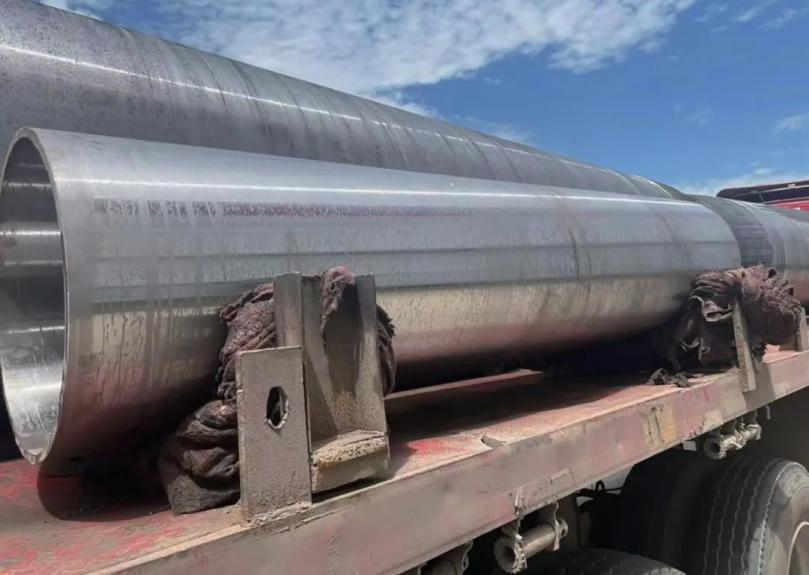 An ultra-long, ultra-thin seamless steel pipe forging has the following specifications: length ≥11000mm, raw pipe wall thickness ≤25mm, finished wall thickness: 15+0.50mm, outer diameter: 800+10mm. This product is widely used in the preparation of blanks for spin forming processes in certain aerospace products. The manufacturing of such ultra-long, ultra-thin, large-diameter seamless steel pipes, especially the control of technical parameters during rolling, heat treatment, and mechanical processing, is extremely challenging. Therefore, it is essential to conduct relevant technical research and discussions. Using 42CrMoA material as an example, we will study its manufacturing process.
An ultra-long, ultra-thin seamless steel pipe forging has the following specifications: length ≥11000mm, raw pipe wall thickness ≤25mm, finished wall thickness: 15+0.50mm, outer diameter: 800+10mm. This product is widely used in the preparation of blanks for spin forming processes in certain aerospace products. The manufacturing of such ultra-long, ultra-thin, large-diameter seamless steel pipes, especially the control of technical parameters during rolling, heat treatment, and mechanical processing, is extremely challenging. Therefore, it is essential to conduct relevant technical research and discussions. Using 42CrMoA material as an example, we will study its manufacturing process.
Manufacturing Process
The manufacturing process of ultra-long, ultra-thin, large-diameter seamless steel pipes includes: steel ingot smelting → billet forging → rough turning → tube rolling → heat treatment → relevant testing → final machining → packaging.
Steel Ingot Smelting
The steel ingot is produced using killed steel smelted in an electric furnace and undergoes secondary refining. The specific smelting route is: Electric Furnace (EF) + Ladle Furnace Refining and Vacuum Treatment (LFV) + Argon (Ar) protected pouring. After solidification, the ingot is hot-transferred to the forging process.
Billet Forging
To meet rolling size requirements, the steel ingot needs to be forged to prepare a suitable billet.
Ingot Heating
The steel ingot is heated before forging.
Billet Forging Formation
The difficulty in billet formation lies in the upsetting of the ingot. Due to the high height-to-diameter ratio of the ingot, it tends to bend during upsetting, requiring repeated straightening before further upsetting. After heating and removal from the furnace, the ingot is clamped 50mm from the riser line, upset with the bottom riser intact, then elongated using a manipulator.
Post-Forging Heat Treatment
After forging, the billet undergoes isothermal annealing, with the main parameter controlled at 620±10°C. The holding time is calculated based on the diameter, at 1.5h/100mm.
Tube Rolling
Rough Turning of Billet
The billet ends are sawn flat, the outer surface is rough turned, and undergoes initial flaw detection.
Rolling Equipment
φ820mm precision oblique rolling mill set (piercing mill, finishing mill).
Rolling Process
The hot rolling process consists of first piercing, second piercing (first heat) + third piercing, and finish rolling (second heat).
Inspection and Testing
After heat treatment, relevant inspections and tests are conducted, including: product analysis, ultrasonic testing, mechanical property testing, non-metallic inclusion analysis, and grain size analysis.
Product Analysis
The results of the product analysis are shown in Table 3.
Table 3: Chemical Composition of the Finished Product (Mass Fraction, %)
Ultrasonic Testing
Acceptance is based on Grade 4 of GB/T 6402-2008 standard. The flaw detection passed.
Final Machining
After passing all inspections and tests, final machining is performed.
The ends are fitted with sleeves and mounted on a lathe. Using the outer surface as a reference, the outer diameter is turned to the final delivery state.
Then, it’s mounted on a deep-hole drilling and boring machine. Using the outer surface as a reference, the inner hole is machined to the final delivery state.
Due to the length ≥11000mm, wall thickness ≤25mm, and diameter ≥800mm, the workpiece is prone to deformation during processing. To address this issue, the following measures are taken:
(1) When machining on the lathe:
a) The ends are fitted with sleeves, with clamping length controlled within 30mm and located outside the main body length.
b) Cutting tools use carbide 90° turning tools.
c) During cutting, the spindle speed is 20-25 r/min, feed rate is 0.2-0.3 mm/r, and cutting depth is controlled at 0.2-0.3 mm.
d) Cutting fluid must be used to cool the tool during cutting.
(2) When machining on the deep-hole drilling and boring machine:
a) Clamping length should be controlled within 30mm and located outside the main body length. At support points, sleeves are used for reinforcement.
b) Cutting tools use carbide indexable inserts.
c) During cutting, the spindle speed is 18-20 r/min, feed rate is 0.2-0.3 mm/r, and cutting depth is controlled at 0.2-0.3 mm.

Leave A Comment